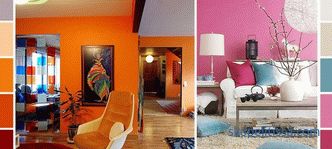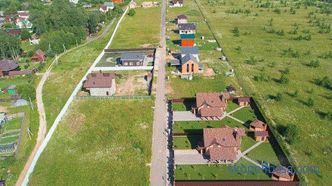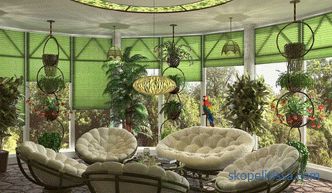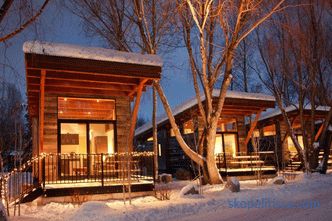The choice of building material is carried out at the initial design stage of the building and is one of its most important tasks. By making this choice correctly, it is possible to ensure not only a warm, comfortable and reliable home, but also to save a great deal of time required to achieve the final result, as well as the amount of financial investments.
It should be borne in mind that the correctness of the choice of material for construction depends on many factors, starting with the type of soil on which the structure will be erected and ending with the required temperature inside. One of the universal types of building materials for the construction of walls of low-rise buildings are expanded clay concrete blocks. Pros and cons of this particular building material, we consider today.
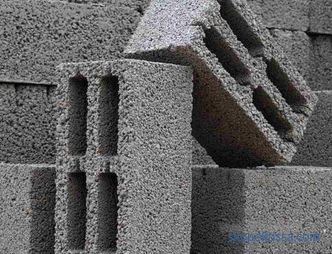
Expanded clay blocks
Advantages and disadvantages
The main advantage of expanded clay concrete blocks is the absence of chemically harmful substances in their composition and connections. Building material is made only from environmentally friendly components, which explains their safety of use for the construction of residential and public buildings. In addition, the advantages of claydite-concrete blocks include:
-
low weight;
-
increased bending and crumbling strength;
-
high vapor barrier properties;
-
low thermal conductivity;
-
resistance to microorganisms, mold and mildew;
-
resistance to temperature extremes;
-
incombustibility.
Using wall claydite-concrete blocks allows you to build buildings in a short period of time, as the technology of working with this material is quite simple and professionals can handle it many times faster than, for example, when using bricks . The size of the expanded clay block also influences the speed of building a house. And using in aggregate other types of construction and finishing materials, you can give the appearance of the building individuality and originality, without spending a large amount of finance.
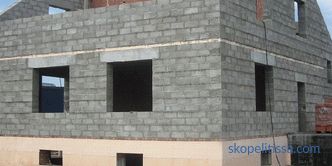
Building a house of claydite-concrete blocks and a brick
The claydite-concrete blocks do not tolerate even not particularly large values of shock and dynamic loads - this is the most significant lack of building material. Another disadvantage is that claydite blocks are poorly amenable to a perfectly even cut.
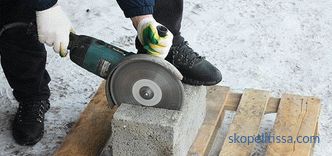
The cutting process of the expanded-clay concrete block
Chipping and cracks are easily formed on the edges of the block during sawing or cutting, which ultimately can affect the appearance of the building. In particular, this must be considered when working with facial elements that will not be additionally veneered. This is an essential argument in order to apply only to those professionals who have sufficient experience in this type of work when building a house of claydite-concrete blocks.
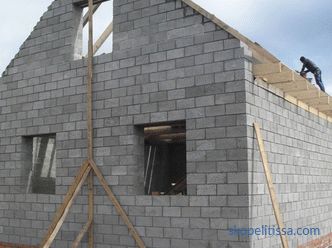
Building a home from claydite-concrete blocks
Main characteristics
The main components of the claydite-concrete blocks are cement, crushed claydite and sand. Depending on which fraction of claydite in the composition, that is, its size, the strength characteristics of the blocks change. The greater the fraction of haydite, the smaller the block strength and thermal conductivity.
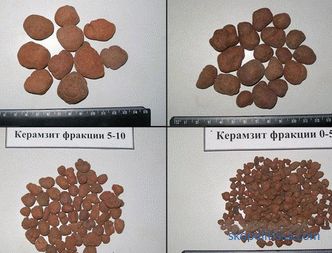
Four different fractions of expanded clay
On our site you can find contacts of construction companies that offer the service of building houses from expanded clay concrete blocks. Directly to communicate with representatives, you can visit the exhibition of houses "Low-rise Country".
The existing dimensions of claydite-concrete blocks are provided for by the standards of GOST 613399, in which they are divided into two main groups, namely:
-
188х190х390 mm - elements intended for the erection of supporting structures of walls ;
-
188x90x390 mm - elements intended for the construction of partitions.
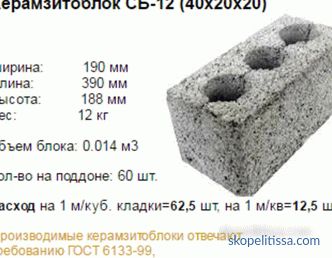
Ceramsite concrete block SB - 12 (188х90х390)
Considering as a building material for partitions or bearing walls houses keramsit concrete blocks, the size you need to choose the appropriate purpose.
Ceramsite concrete blocks are divided into facial and ordinary, full-bodied and with the presence of voids. The facial ones are designed to create structures that do not need additional finishing, while ordinary ones are additionally veneered with a finishing material.
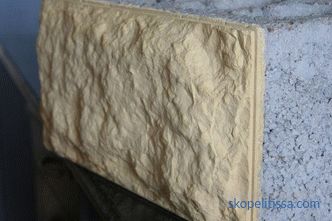
Facial lightweight aggregate block
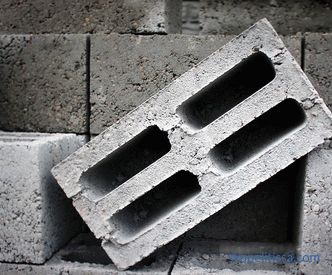
Common lightweight aggregate block
The separation of lightweight aggregate blocks into hollow and solid bodies is carried out by the presence of cavities in their design, the purpose of which is to reduce the weight of individual elements.In addition, the holes in the hollow blocks increase its thermal insulation properties, but reduce strength and reliability when exposed to loads. The full block has no holes.
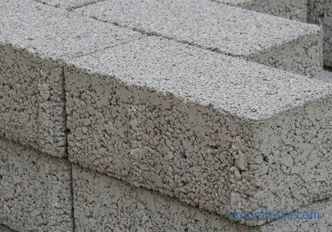
Full-body expanded-clay concrete blocks
It might be interesting! In the article the following link read about ceramic blocks .
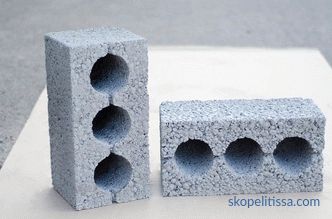
Hollow claydite-concrete blocks (3 hollow)
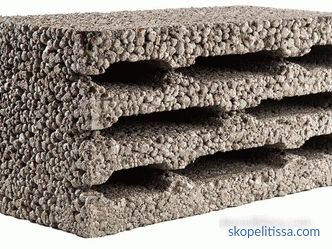
8- mi hollow claydite-concrete block
It should be borne in mind that the clay-filled block dimensions may not be accurate. Permissible deviation in width, height and length is a value equal to from 10 to 20 mm.
Density and strength
When choosing a building material for the construction of load-bearing walls, it is necessary to pay attention to such characteristics as density and strength. The reliability of the finished structure depends on the latter, and its heat-saving and acoustic properties depend on the density. The density of the blocks is in the range from 500 to 1800 kg / m³, while the claydite-concrete blocks weigh accordingly from 10 to 23 kg.
In turn, the strength varies from 3.5 to 20, which corresponds to static loads in the range from 35 to 250 kg / cm². These parameters provide the duration of the operating period of at least 60 years.
See the video for a simple strength test of expanded clay concrete blocks:
Frost resistance and fire resistance
Not a small role in the durability of the structure plays the frost resistance of the building material. It is determined by experiment, during the freezing and thawing, completely saturated with water claydite-concrete block. Currently, GOST is set 4 main brands that differ in frost resistance, namely: F25, F35, F50 and F75.
The higher the number after the letter, the greater the number of freeze and thaw cycles that the claydite-concrete block can withstand.
The fire resistance of the blocks of expanded clay concrete has the highest class. If the effect of an open flame on a lightweight aggregate does not exceed 7-10 hours, then nothing will happen to it.
For more information on claydite-concrete blocks, look at the video:
Pros and cons of houses from claydite-concrete blocks
Houses made of expanded clay blocks have their advantages and disadvantages. The main positive aspects of construction and finished structures include:
-
Financial benefit. Spending is significantly reduced due to the low cost of the material and work with it, and since the construction of expanded clay is not heavy, then a reinforced foundation is not required, it also saves money.
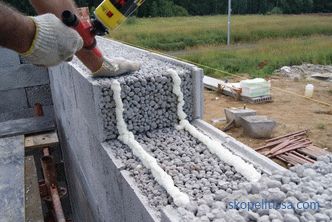
The process of laying claydite-concrete blocks
-
Warm home. Thanks to the porous filler of the blocks - expanded clay, the designs from them keep heat well.
-
The walls of the house of expanded clay concrete blocks are durable, freely withstand the load of floor slabs.
-
Homes of high-quality expanded clay blocks are practically not subject to shrinkage, which prevents the formation of microcracks in the walls.
-
The building material is environmentally friendly, which means the scrap walls do not emit any harmful substances.
-
Good insulation in the house.
-
Plaster fits well on walls made of expanded clay concrete blocks.
It should be noted that the porosity of expanded clay blocks is both a plus and a minus. The building material absorbs water well, and when the frost comes, the moisture crystallizes and begins to destroy the structure of the block. Therefore, houses of expanded clay blocks should be protected from moisture ingress facing materials.
Disadvantages can also be called the emergence of cold bridges, which can be reduced only by thermal insulation. Bridges of cold arise in the seams between the individual elements.
It is also possible to attribute the dimensions of a block of expanded clay concrete to minuses, or rather their limited choice - there are only two of them and they differ only in width - there is no possibility to choose the thickness of the walls of the house.

A wall made of expanded clay concrete blocks, insulated with foam and lined with brick
It is also worth noting that due to the fragility of the blocks they are fragile the basis for fixing dowels and other types of fastenings. Therefore, to choose materials for interior and exterior decorating should be guided by this condition.
House of claydite-concrete: a new trend in modern construction
Low-rise houses made using blocks of claydite-concrete can be safely called a new trend in modern construction.Using this material as the main one when erecting external walls and internal partitions, the time for performing work, their cost, and the heat supply of an already finished building are greatly reduced.
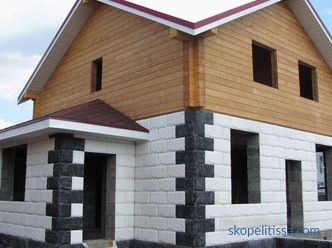
House: ground floor front of claydite-concrete blocks and attic from a bar
Thanks to all the advantages, the construction of turnkey-claydite concrete blocks is much more acceptable, and therefore more families will be able to afford their own private home.
Thus, choosing the claydite-concrete blocks as the main material for the construction of your house, you can count not only on the operational deadlines for the work, but also on their fairly reasonable cost. And this can be called one of the most powerful arguments for those who decided to move from the bustle of a bustling city closer to nature.
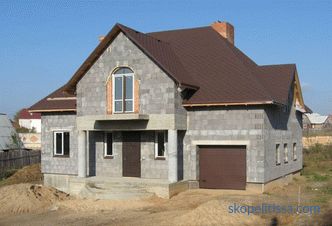
A large house with an attic and a garage of expanded clay concrete blocks
It might be interesting! In the article on the following link read about hozbloki to give.
Conclusion
Ceramsite concrete blocks as a building material are becoming more and more popular every year. If you want to save a little, contact the construction company, where you will be offered ready-made projects of houses made of expanded clay concrete blocks or will make a unique project, based on your wishes.
